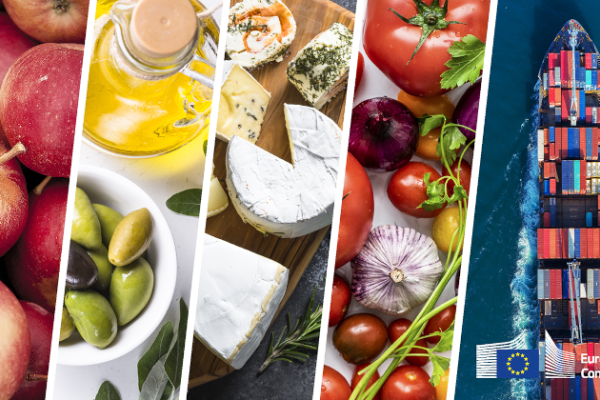
EU agri-food trade reached a total value of €34.9 billion in May 2022, an increase of 11% month-to-month and an increase of 32% compared to May last year. This has largely been driven by the continuing increase in prices of commodities. Exports were valued at €19.4 billion. This reflects growth of 8% month-to-month and 21% compared to May 2021, with higher volumes of wheat and maize but lower volumes of other grain exports.
Imports reached a value of €15.6 billion, an increase of 15% compared to April and 48% higher than May of last year. This was mainly caused by sharp increases in import volumes of maize, and higher prices of coffee and nuts. These findings were published today in the European Commission’s monthly agri-food trade report, which features a special examination of the EU agri-food trade balance from the year 2000 until now.
Developments in May
Exports to the Middle East and North Africa remained stable month-to-month but were still 44% higher compared to May 2021. Exports of cereals and cereal preparations grew by 75% year-on-year to reach €919 million, with export quantities and values both increasing. Wheat exports in particular saw sharp growth, increasing by 35% compared to May 2021. Notably, wheat exports increased by 625% to Morocco and by 208% to Tunisia.
Exports to Ukraine have recovered to pre-invasion levels, growing 27% monthly to reach €233 million. Exports of vegetables and pigmeat to Ukraine exceeded figures for May 2021 in terms of both value and volume. Export volumes for these increased by 102% and 148% respectively.
Imports have reached record levels, growing by 15% from April to hit €15.6 billion. This follows a substantial increase of 17% in March. Imports from Brazil rose by 41% month-to-month and 84% compared to May 2021 due to increases in prices and quantities. The largest increases were seen in oilseeds and cereals, which grew monthly by €459 million and €72 million respectively.
Imports from Ukraine grew by 36% to reach €665 million, with the largest rise seen in imports of oilseeds (+83%) and cereals (+67%). This growth was mostly quantity driven. Imports of poultry and eggs also increased significantly in May at a lower price, with volumes rising by 106% and the unit import price declining by 4%.
Developments January-May
The primary export destinations for EU agri-food products are the United Kingdom, United States and China. Exports to the UK were 21% higher in the first five months of this year, compared to 2021. This was largely driven by cereal preparations (+€334 million or 22%), wine (+€182 million or 17%) and poultry meat (+€176 million or 48%).
Exports to China remain low, at €5.7 billion for the January-May period. This is a decrease of 29% compared to last year. Exports to sub-Saharan Africa have increased by 15% to reach a value of €4.6 billion. While this is mainly the result of increased commodity prices, it also due to growth in export quantities of products such as sunflower oil (+972%), white sugar (+65%) and maize (+56%).
Regarding imports, those from Brazil, the UK and China increased the most compared to last year, growing by 51%, 40% and 69% respectively. Imports from China reached €3.7 billion, mainly due to fatty acids and waxes, and pet food. Imports from Australia increased by 124% to reach €1.9 billion, with the main imports being rapeseed (€1.4 billion), wool and silk (€97 million), and wine (€90 million).
Specific product categories
For the January-May period, the largest increase in exports was seen in cereals, which grew by €1.5 billion or 33% compared to last year. There was also strong growth seen in exports of cereal preparations and milling products (+€1.3 billion or 18%) and dairy products (+€1.1 billion or 16%). Butter exports increased in both value and volume, while exports of milk powders (whey, skimmed milk powder and whole milk powder) grew in value but not volume.
Looking at imports, the value of coffee imports grew by €2 billion in the January-May period. Maize imports also increased substantially, growing by €1.1 billion. While maize imports also increased in quantity by 44%, coffee imports were primarily driven by a price increase, with volumes only growing by 7%. Imports of fruit and nuts also grew strongly to reach €9.3 billion, an increase of 8%. Increased volumes of nuts mainly came from the US, Turkey and Vietnam.
More insights as well as detailed tables are available below in the latest edition of the monthly EU agri-food trade report.
More information

Details
- Publication date
- 6 September 2022
- Author
- Directorate-General for Agriculture and Rural Development



